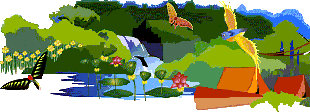|
|
|
 |
 |
| Leaf structure of the Staghorn plants |
|
Epiphytic fern borrows the use of a tree's branches from its host. Branches of the tree is where it anchors itself. The fern does not live off its host . It survives on the nutrients it has collected from droppings. Staghorn Fern There are only one dozen species from this remarkable genus, one in South America, the rest in Africa, Madagascar, and Malaysia to Australia. The name Staghorn fern is given because of the resemblance of the repeatedly branched erect fertile fronds to the antlers of the stag. Most spores get landed on horizontal surfaces of branches or at joints with branches spreading out. There the leaf fronds starts building up a basin. When spores get blow to the lower level, Rubber trees is the most preferred host where young plants thrive readily.
More nest fronds will reinforce its anchorage until the plant is comfortable. The Staghorn Fern live on the host tree without any root visible! For roots, they have fleshy-branched rhizome covered, with its roots by the nest leaves. The leaves of the Staghorn ferns called are unstalked. There are 2 kinds of leaves: 1] Nest leaves The blades are erect and with broad lamina. The basal part of leaves is thick and fleshy. The dry leaves of the old fronds would curl inwards holding the litters they have collected in their life and at the same time, this action provides shelter to the roots from dehydration.
Picture shows a regular leaf frond and another young leaf in the budding stage. This new leaf will wrap round the existing nest as the next laminating layer. They are prefect litters trap and completely protects the roots and rhizome.
Among and at the base of certain fertile frond, there is also another kind of growth. This is the fertile lobe that carries the spores for propagation.
The spores [sporangia] are scattered over large area on the various part of the lower surface Top - Picture of a matured fertile frond. Bottom -one in growing stage
The nest leaves remain as part of the plant all the time. The fertile leaves fall off when they are old.
|
![]()
The Staghorn Ferns - know a little bit more about the plant
|
Go back to Nature Park Index | main page | About Us | BACK